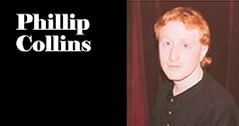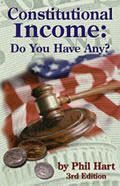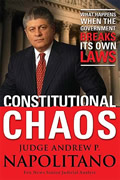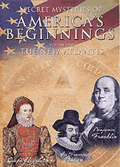Other
Collins
Articles:
Darwinism and the Rise of Gnosticism
Engineering Evolution: The Alchemy of Eugenics
NOTHING
BEYOND THE FLESH: THE THEOCRACY OF PRIMA MATERIA
PART 1 of 5
Phillip
D. Collins
October 7, 2006
NewsWithViews.com
Anatomy of a Weltanschauungskrieg
Historically, humanity has divided somewhat evenly into two diametrically opposed camps: those who subscribe to a spiritual, theistic Weltanschauung and those who do not. The philosophical milieu of ancient Greece illustrates this division. In the theistic camp, one would find the likes of Socrates and Plato. In the atheistic camp, one would find Democritus and Protagoras. While the more deistic philosophies of both Lucretius and Aristotle might present some exceptions to this division, one could convincingly argue that deism is little more than a camouflaged form of atheism.
Since the inception of the anti-theistic and anti-spiritual Weltanschauung, numerous permutations of this philosophical camp have emerged. Materialists, behaviorists, physicalists, functionalists, secular humanists, and Marxists are just a few of the resulting variants. To be sure, the countless theoreticians of these anti-theistic and anti-spiritual camps have had their occasional epistemological feuds. Yet, all share the same core metaphysical convictions: matter holds primacy and the ontological plane of the physical universe constitutes the totality of reality itself.
Of course, the anti-theistic and anti-spiritual Weltanschauung adamantly opposes most, if not all, religions. However, most contemporary movements that have ostensibly eschewed a spiritual outlook have sociologically behaved like religions. Communism and fascism are two such cases in point. How does one explain this paradox? It is this researcher's contention that the anti-theistic and anti-spiritual Weltanschauung was spawned by an older religion. This religion is purely occult in character and, because it acted as the progenitor for the anti-theistic and anti-spiritual Weltanschauung, it remains deeply embedded within the ostensibly secular mind. Thus, even the most stridently secular movements are conceptually predisposed to religious thought and behavior. Ultimately, the anti-theistic and anti-spiritual Weltanschauung is designed to relocate the Eschaton of Heaven and Hell within the ontological plane of the physical universe. Simultaneously, it relocates God within man himself. The final result is a control ideology devoted to the transformation of prima materia and a secular religion devoted to the apotheosis of man.
Secular Humanism: The Religion of Man Apotheosized
To be sure, not every claim of paranormal or supernatural experience is genuine. More than a few have been the products of sensationalism and superstition. However, the outright rejection of all extraordinary possibilities is symptomatic of epistemological rigidity, which can stultify the broadening of human knowledge and the expansion of methods for scientific inquiry. While institutionally accredited science has typically eschewed the paranormal and supernatural, segments of the scientific establishment are beginning to acknowledge the centrality of supra-sensible entities to the examination of sensible phenomena. In fact, many theoretical physicists and bio-physicists have observed that science and mysticism are assuming convergent trajectories. Scientific materialists typically suppress such contentions.
Regular viewers of the National Geographic channel have probably already noticed the cable station's overall prejudice towards the belief in a supernatural reality and a transcendant God. Members of CISCOP (Committee for the Scientific Investigation of Claims of the Paranormal) routinely appear on National Geographic programs, offering so-called "scientifically credible explanations" for otherwise unexplained phenomena. What the National Geographic channel fails to mention is the fact that CISCOP members are already ideologically predisposed to reject God and the supernatural. Many CISCOP members are also secular humanists. To understand what secular humanists believe, one need look no further than 1973's second Humanist Manifesto for a succinct synopsis:
As in 1933, humanists still believe that traditional theism, especially faith in a prayer-hearing God, assumed to love and care for personas, to hear and understand their prayers, and to be able to do something about them, is an unproved and outmoded faith. Salvationism, based on mere affirmation, still appears as harmful, diverting people with false hopes of heaven hereafter. Reasonable minds look to other means of survival. (No pagination)
Encapsulated within this declaration is the anthropocentric aphorism of Protagoras: "Man is the measure of all things." Human reason dethrones God and becomes the chief facilitator for man's salvation. Salvation is redefined within a purely Darwinian context as survival and the continuity of the species becomes synonymous with immortality. If this Weltanschauung seems religious in character, it is because it is actually the second oldest faith in existence. Whittaker Chambers, former member of the communist underground in America, eloquently observed:
"Humanism is not new. It is, in fact, man's second oldest faith. Its promise was whispered in the first days of Creation under the Tree of the knowledge of Good and Evil: 'Ye shall be as gods.'" (Qutd. in Baker 206)
Simply stated, humanism is the religion of self-deification. Its god is Man, spelled with a capital M to connote the purported divinity intrinsic to humanity. Atheism provides the philosophical segue for the enthronement of this god. This enthronement begins with the recognition of a significant paradox inherent to atheism. Authors Ron Carlson and Ed Decker explain:
It is philosophically impossible to be an atheist, since to be an atheist you must have infinite knowledge in order to know absolutely that there is no God. But to have infinite knowledge, you would have to be God yourself. It's hard to be God yourself and an atheist at the same time! (17)
Indeed, to conclude with all certainty that there is no transcendant God outside the ontological plane of the physical universe, one must first claim omniscience. However, omniscience is a trait reserved exclusively for deities. Therefore, the claimant must conclude that he or she is a god. In this sense, atheism is not the rejection of a deity. Instead, it is the belief in emergent deity. The god that is gradually evolving is Man himself and his development is guided by his own cognitive powers.
Again, this belief is nothing new. It was central to the religious doctrines of the ancient Mystery cults, which were prominent in Babylon and Egypt. Ever-present was the theme of humanity made divine through the enthronement of man's reason. S. Angus contends that the central theme of the Mystery religions was "that the march of mankind is Godward" (43). Of course, not every adherent of the Mysteries necessarily subscribed to this doctrine of apotheosis. Numerous motives compelled people to accept the religion. Angus wisely observes:
Men entered the Mystery-cults for different purposes: there were all degrees of belief and unbelief, morality and laxity, mysticism and realism. The carnal could find in orgiastic processions and midnight revels opportunities for self-indulgence; the superstitious would approach because of the magical value attributed to the formulae and sacraments; the educated could, in the material and physical, perceive symbols of the truth dear to his heart; the ascetic would look upon initiation as a means of buffeting his body and giving freedom to the spirit; the mystic would in enthusiasm or ecstasy enjoy the beatific vision by entering into communion with God or by undergoing deification. (42)
Thus, only the most ardent mystics accepted the inner doctrine of apotheosis. For the more carnally inclined, such doctrine was seldom acknowledged. In fact, few were even aware of it. The ultimate objective of self-deification was veiled by secrecy and semiotic manipulation:
The secrecy with which the Mysteries terminated behind the veil of the temple, compared with the publicity with which they generally commenced in the streets, is explicable from the fact that the things "done" or "said" were not the things actually to be revealed but merely symbolic means of conveying the intended truth to the minds of the votaries. (62)
A similar culture of obscurantism exists in Freemasonry, which acts as the retainer of the ancient Mystery religion. In fact, humanism and Masonry have shared a long historical relationship. In The Keys of this Blood, deceased Vatican insider Malachi Martin examined the emergence of "a network of Humanist associations" throughout early-Renaissance Italy (518-19). These organizations represented: a revolt against the traditional interpretation of the Bible as maintained by the ecclesiastical and civil authorities, and against the philosophical and theological underpinnings provided by the Church for civil and political life. (519) Although these groups espoused an ostensible belief in God, their notions of a Supreme Being were largely derivative of the Kabbala:
Not surprisingly given such an animus, these associations had their own conception of the original message of the Bible and of God's revelation. They latched onto what they considered to be an ultrasecret body of knowledge, a gnosis, which they based in part on cultic and occultist strains deriving from North Africa-notably, Egypt-and, in part, on the classical Jewish Kabbala. (519)
In Morals and Dogma, 33rd Degree Freemason Albert Pike reveals that "all the Masonic associations owe to it [the Kabbala] their Secrets and their Symbols" (Pike 744). According to Martin, however, the early humanists modified this ancient Hebraic doctrine considerably:
Whether out of historical ignorance or willfulness of both, Italian humanists bowdlerized the idea of Kabbala almost beyond recognition. They reconstructed the concept of gnosis, and transferred it to a thoroughly this-worldly plane. The special gnosis they sought was a secret knowledge of how to master the blind forces of nature for a sociopolitical purpose. (519-20)
Many of the semiotic artifacts comprising the early humanists' iconography and jargon were also directly related to Masonry:
Initiates of those early humanist associations were devotees of the Great Force--the Great Architect of the Cosmos--which they represented under the form of the Sacred Tetragrammaton, YHWH, the Jewish symbol for the name of the divinity that was not to be pronounced by mortal lips. They borrowed other symbols--the Pyramid and the All-Seeing Eye--mainly from Egyptian sources. (Martin 520)
The Great Architect of the Cosmos, the All-Seeing Eye, and the Pyramid also comprise the esoteric semiology of Freemasonry. What is the explanation for all of these commonalities? According to Martin, these shared characteristics were the result of a merger between the humanists and the old Mason guilds:
In other northern climes, meanwhile, a far more important union took place, with the humanists. A union that no one could have expected. In the 1300s, during the time that the cabalist--humanist associations were beginning to find their bearings, there already existed--particularly in England, Scotland and France-medieval guilds of men who worked with ax, chisel and mallet in freestone. Freemasons by trade, and God-fearing in their religion, these were men who fitted perfectly into the hierarchic order of things on which their world rested. (521)
Evidently, there couldn't have been two organizations that were more diametrically opposed than Masonry and humanism:
No one alive in the 1300s could have predicted a merger of minds between freemason guilds and the Italian humanists. The traditional faith of the one, and the ideological hostility to both tradition and faith of the other, should have made the two groups about as likely to mix as oil and water. (Martin 522)
Nevertheless, the late 1500s would witness the amalgamation of these two groups (Martin 522). The most evident corollary of this organizational coalescence was a noticeable difference in recruiting practices:
As the number of working or "operative," freemasons diminished progressively, they were replaced by what were called Accepted Masons--gentlemen of leisure, aristocrats, even members of royal families--who lifted ax, chisel and mallet only in the ultrasecret symbolic ceremonies of the lodge, still guarded by the "Charges" and the "Mason Word." The "speculative" mason was born. The new Masonry shifted away from all allegiance to Roman ecclesiastical Christianity. (Martin 522)
Indeed, the new Masonic doctrine appeared to be one that thoroughly eschewed Christian concepts:
There was no conceptual basis by which such a belief could be reconciled with Christianity. For precluded were all such ideas as sin, Hell for punishment and Heaven for reward, and eternally perpetual Sacrifice of the Mass, saints and angels, priest and pope. (522)
The new Mason was no longer an architect of freestone. Instead, he was an architect of a Novus Ordo Seclorum. Out of the Lodge would spring many varieties of sociopolitical Utopianism. Countless revolutionaries would rise up against the dominant ecclesiastical authority and attempt to install their own theocratic order. To be sure, much of the ecclesiastical establishment was corrupt and in desperate need of reform.
|
Subscribe to the NewsWithViews Daily News Alerts! |
However, the "alternative" offered by sociopolitical Utopians was far more authoritarian than any of its religious counterparts. Moreover, their Novus Ordo Seclorum was no less religious in character. The new secular faith eviscerated the heavens and relocated all of religion's traditional metaphysical concepts within the ontological plane of the physical universe. The ultimate eschatological vision of this revolutionary faith was the enthronement of the secular humanists' god: Man. For part two click below.
Click Here for part -----> 2, 3, 4, 5,
Sources Cited:
1.
Angus, S. The Mystery-Religions: A Study in the Religious Background
of Early Christianity. New York: Dover Publications, 1975.
2. Aquinas, Thomas. Summa Theologiae. Pt. I, Qu. 86, Art. I,
in Basic Writings of Saint Thomas Aquinas. Ed. Anton C. Pegis (New
York: Random House, 1945), I.
3. Bainbridge, William Sims. "Religions for a Galactic Civilization."
Excerpted from Science Fiction and Space Futures, edited by Eugene
M. Emme. San Diego: American Astronautical Society, pages 187-201,
1982.
4. Baker, Jeffrey. Cheque Mate: The Game of Princes. Springdale,
PA: Whitaker House, 1995.
5. Billington, James H. Fire in the Minds of Men: Origins of
the Revolutionary Faith. New York: Basic, 1980.
6. Carlson, Ron, Ed Decker. Fast Facts on False Teachings.
Eugene, Oregon: Harvest House Publishers, 1994.
7. Coomaraswamy, Rama. "The Fundamental Nature of the Conflict
Between Modern and Traditional Man--Often Called the Conflict Between
Science and Faith." 2001. Coomaraswamy Catholic Writings. 26 August
2005.
8. de Hoyos, Linda. "The Enlightenment's Crusade Against Reason."
The New Federalist 8 Feb. 1993.
9. Dubos, Rene J. Louis Pasteur: Free lance of Science. New
York: Charles Scribner's Sons, 1976.
10. Fischer, Frank. Technocracy and the Politics of Expertise.
Newbury Park, California: Sage Publications, 1990.
11. Guenon, Rene. The Reign of Quantity and the Signs of the
Times. Trans. Lord Northbourne. Baltimore, Maryland: Penguin Books
Inc, 1953.
12. Hickman, R. Biocreation. Worthington, Ohio: Science Press,
1983.
13. Hoffman, Michael. Secret Societies and Psychological Warfare.
Coeur d'Alene, Idaho: Independent History & Research, 2001.
14. Hooykaas, Reijer. Religion and the Rise of Modern Science.
London: Chatto and Windus, 1972.
15. Howard, Michael. The Occult Conspiracy. Rochester, Vermont:
Destiny Books, 1989.
16. Huxley, Aldous. Brave New World Revisited. New York: Bantam
Books, 1958.
17. Kelly, Rev. Clarence. Conspiracy Against God and Man. Appleton,
WI: Western Islands, 1974.
18. Kurtz, P. and E.H. Wilson, eds. Humanist
Manifesto II. 1973.
19. Lewin, Leonard, ed., The Report from Iron Mountain on the
Possibility and Desirability of Peace. New York: Dell Publishing,
1967.
20. Martin, Malachi. The Keys of this Blood. New York: Simon
and Schuster, 1991.
21. Pesce, Mark. "Ontos and Techne." Computer-Medicated Magazine,
April 1997
22. Pittenger, Mark. American Socialists and Evolutionary Thought,
1870-1920. Madison: Wisconsin UP, 1993.
23. Raschke, Carl A. The Interruption of Eternity: Modern Gnosticism
and the Origins of the New Religious Consciousness. Chicago: Nelson-Hall,
1980.
24. Rummel, R.J. Freedom, Democide,
War. 13 March 2000. U of Hawaii. 19 September 2003.
25. Shermer, Michael. "The
Shamans of Scientism." Scientific American. 13 May 2002.
26. Taylor, Ian T. In the Minds of Men: Darwin and the New
World Order. Toronto: TFE Publishing, 1999.
27. Wagar, W. Warren. H.G. Wells and the World State. New Haven,
CT.: Yale UP, 1961.
28. Webb, James. The Occult Establishment. Open Court, 1976.
29. Wilder-Smith, B. The Day Nazi Germany Died. San Diego,
CA: Master Books, 1982.
� 2006 Phillip D. Collins
- All Rights Reserved
Phillip D. Collins acted as the editor for The Hidden Face of Terrorism. He has also written articles for Paranoia Magazine, MKzine, NewsWithViews, B.I.P.E.D.: The Official Website of Darwinian Dissent, the ACL Report, Namaste Magazine, and Conspiracy Archive. In 1999, he earned an Associate degree of Arts and Science. In 2006, he earned a bachelors degree with a major in communication studies and a minor in philosophy. During the course of his seven-year college career, Phillip has studied philosophy, religion, and classic literature.
He has recently completed a newly expanded and revised edition of The Ascendancy of the Scientific Dictatorship (ISBN 1-4196-3932-3), which is available at Amazon.com. He is also currently co-authoring a collection of short stories, poetry, and prose entitled Expansive Thoughts. It will be available late Fall of 2006.
E-Mail: collins.58@wright.edu
Of course, the anti-theistic and anti-spiritual Weltanschauung adamantly opposes most, if not all, religions.














